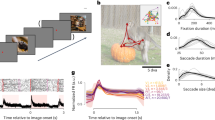Abstract
A SLOW form of rod dark adaptation lasting tens of minutes has been observed in isolated retinae1–5, including those of the rat6,7, following exposures to intense lights which bleach significant proportions of the rod pigment. Yet in the isolated rat retina in similar circumstances it has been reported8,9 that the cells which produce the b wave of the electroretinogram adapt within minutes. Since this adaptation is finished before any of the slow thermal reactions of rhodopsin bleaching reach completion, a ‘neural’ basis for the phenomenon has been suggested. Experiments10 have, however, confirmed earlier work11 showing that there is more than one pigment in the rat. This provides an alternative explanation for the fast adaptation of the rat b wave. We have been able to demonstrate that during the fast adaptation the dominant input to the cells producing the b wave comes from the non-rhodopsin pigment system. We have also found conditions in which the b wave shows the slower form of adaptation. Then, the dominant input to the b-wave cells is from a rhodopsin-based mechanism.
This is a preview of subscription content, access via your institution
Access options
Subscribe to this journal
Receive 51 print issues and online access
$199.00 per year
only $3.90 per issue
Buy this article
- Purchase on Springer Link
- Instant access to full article PDF
Prices may be subject to local taxes which are calculated during checkout
Similar content being viewed by others
References
Bender, S., and Baumann, C., Pflügers Arch., 341, 219–232 (1973).
Frank, R. N., Vision Res., 11, 1113–1123 (1971).
Grabowski, S. R., and Pak, W. L., J. Physiol., Lond., 247, 363–392 (1975).
Hood, D. C., Hock, P. A., and Grover, B. G., Vision Res., 13, 1953–1963 (1973).
Witkovsky, P., Nelson, J., and Ripps, H., J. gen. Physiol., 61, 401–423 (1973).
Ernst, W., and Kemp, C. M., Vision Res., 12, 1937–1946 (1972).
Kemp, C. M., Biochemistry and Physiology of Visual Pigments, 307–312 (Springer, Berlin, 1973).
Frank, R. N., and Dowling, J. E., Science, 161, 487–489 (1968).
Weinstein, G. W., Hobson, R. R., and Dowling, J. E., Nature, 215, 134–138 (1967).
Green, D. G., J. Physiol. Lond., 228, 781–797 (1973).
Dodt, E., and Echte, K., J. Neurophysiol., 24, 427–445 (1961).
Ernst, W., and Arden, G. B., Vision Res., 12, 1759–1761 (1972).
Miller, R. F., and Dowling, J. E., J. Neurophysiol., 33, 323–341 (1970).
Weinstein, G. W., and Hobson, R. R., Nature, 227, 957–959 (1970).
Rodieck, R. W., The Vertebrate Retina, 690–709 (Freeman, San Francisco, 1973).
Author information
Authors and Affiliations
Rights and permissions
About this article
Cite this article
ERNST, W., KEMP, C. Scotopic and photopic dark adaptation of the b wave in isolated rat retina. Nature 258, 170–171 (1975). https://doi.org/10.1038/258170a0
Received:
Accepted:
Issue Date:
DOI: https://doi.org/10.1038/258170a0
Comments
By submitting a comment you agree to abide by our Terms and Community Guidelines. If you find something abusive or that does not comply with our terms or guidelines please flag it as inappropriate.



